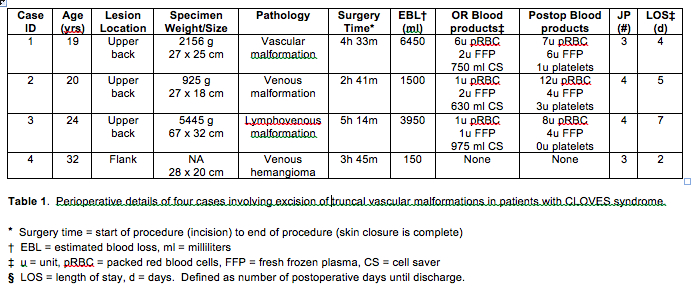Back to 2014 Annual Meeting Abstracts
Perioperative Management of Large Vascular Malformations in the Setting of CLOVES syndrome
Valeriy Shubinets, MD, Hoang Nguyen, MD, David W. Low, MD.
University of Pennsylvania, Philadelphia, PA, USA.
Background: Congenital lipomatous overgrowth, vascular malformations, epidermal nevi, and skeletal abnormalities (CLOVES) syndrome is a relatively new entity in the medical literature. Described recently by Sapp et al. 2007 (7 patients) and Alomari et al. 2008 (18 patients), CLOVES is a rare condition that is distinct from other overgrowth syndromes with complex vascular anomalies such as Proteus syndrome. Clinical features of CLOVES include large truncal masses, acral deformities, scoliosis, and cutaneous nevi. The large truncal masses, which have been characterized either as vascular malformations or as lipomatous lesions with variable vascular component, frequently necessitate surgical excision. However, limited data exists in literature regarding the perioperative details of these procedures. We hereby present data from the excision of four large truncal vascular malformations in three patients with CLOVES syndrome, including the length of operation, estimated blood loss (EBL), amount of blood products transfused, specimen pathology and weight, and length of hospital stay.
Methods: A retrospective review of three patients with CLOVES syndrome who underwent excision of truncal vascular malformations by the senior author (DWL) at Children’s Hospital of Philadelphia and Hospital of the University of Pennsylvania was performed. Detailed records of each admission were obtained and protected under the HIPAA and University of Pennsylvania IRB guidelines.
Results: Perioperative details of each case are summarized in Table 1. Of note, one patient underwent two separate surgeries for two distinct masses (case 1 and 2). Average patient age at the time of operation was 24 years. All lesions were located on the upper back or flank with various degree of muscle involvement. One case required no transfusion of blood products and had an uneventful 2-day hospital course. The remaining three cases had an EBL ranging from 1500 to 6450 mL, requiring 9-13 units of packed red blood cells and 5-8 units of fresh frozen plasma during the hospital stay, which averaged over 5 days. The specimen weight ranged from 925 to 5445 g. Average surgery time was 4 hours and 3 minutes. All patients required a minimum of three Jackson-Pratt (JP) drains at the end of the case.
Conclusion: CLOVES is a rare and recently described syndrome. We present our experience with the perioperative management of truncal vascular malformations associated with this condition. These masses are often large and their excision frequently requires long operative times and significant transfusions. Careful planning and patient education are of paramount importance. Preoperative imaging to define the vascularity of these lesions and adjunctive procedures such as embolization are some of the strategic options that can be considered prior to surgical excision to decrease intraoperative blood loss.

Back to 2014 Annual Meeting Abstracts
|




